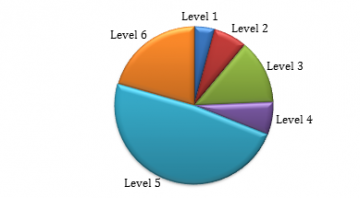Prisoners not involved in work or education programs were far more likely to commit assaults on staff than prisoners who were busy. Almost three quarters of prisoners were unemployed or underemployed at the time they assaulted staff.
Figure: Prisoner’s gratuity level at time of assault
Gratuities or payments are made to prisoners on a weekly basis. The amount a prisoner is paid is dependent on their level of engagement in work or education. The levels range from one to six where one equates to the greatest level of involvement and six the least.
Prisoners who are not working and receiving no income are considered level six. This occurs when a person refuses work, a Superintendent directs them not to work, or they are confined to their cell as part of behaviour management. Prisoners who are awaiting work are allocated gratuity level five. Gratuity level four is earned by those undertaking unit worker positions, which is notorious for requiring very little effort, and typically involves no more than mopping or sweeping a specified area of the unit. In some cases this work would only occupy a prisoner for an hour or less each day. People on level four to level six gratuities are considered by this Office as either unemployed or underemployed.
Prisoners in less skilled work roles, part time employment or full time programs can earn level three gratuities. Level two gratuities are earned by long term workers or prisoners engaged in full time education. Level one prisoners are employed in a trade or are working towards trade skills.
This Office has consistently raised concerns in recent years regarding facilities which lack real opportunity for meaningful job skilling and accredited training. A recent inspection of Casuarina Prison revealed that almost half of Casuarina’s prisoners were unemployed or underemployed. This led to a recommendation that the Department should ensure all eligible prisoners at Casuarina are offered meaningful employment or education and skill development activity. Similar findings were present at the 2012 inspections of Greenough and Hakea prisons where unemployment and underemployment were significant problems.
